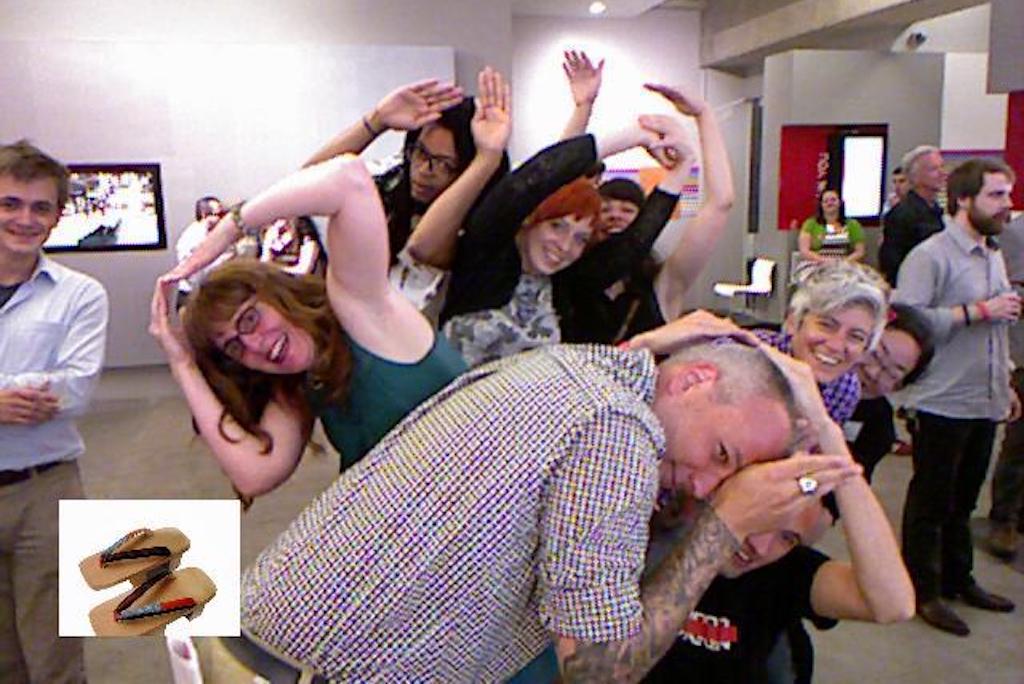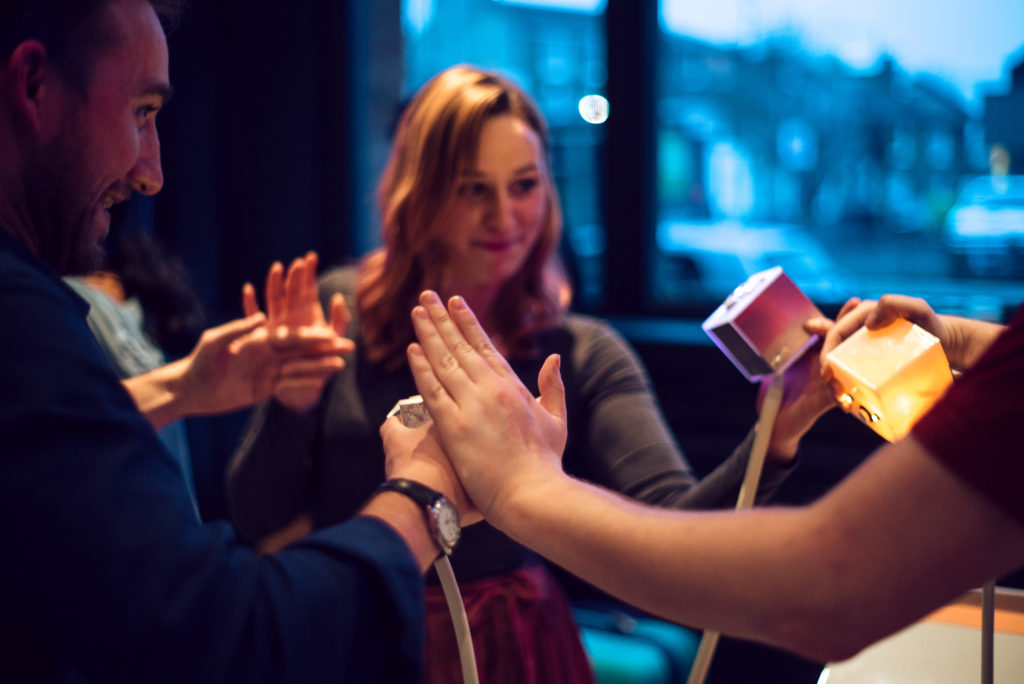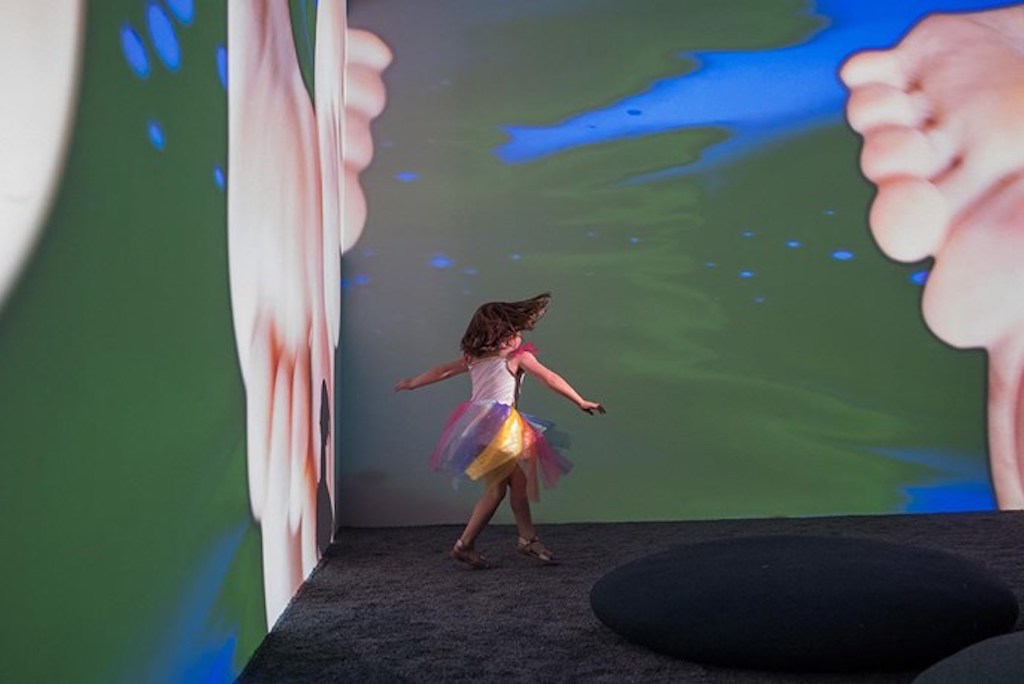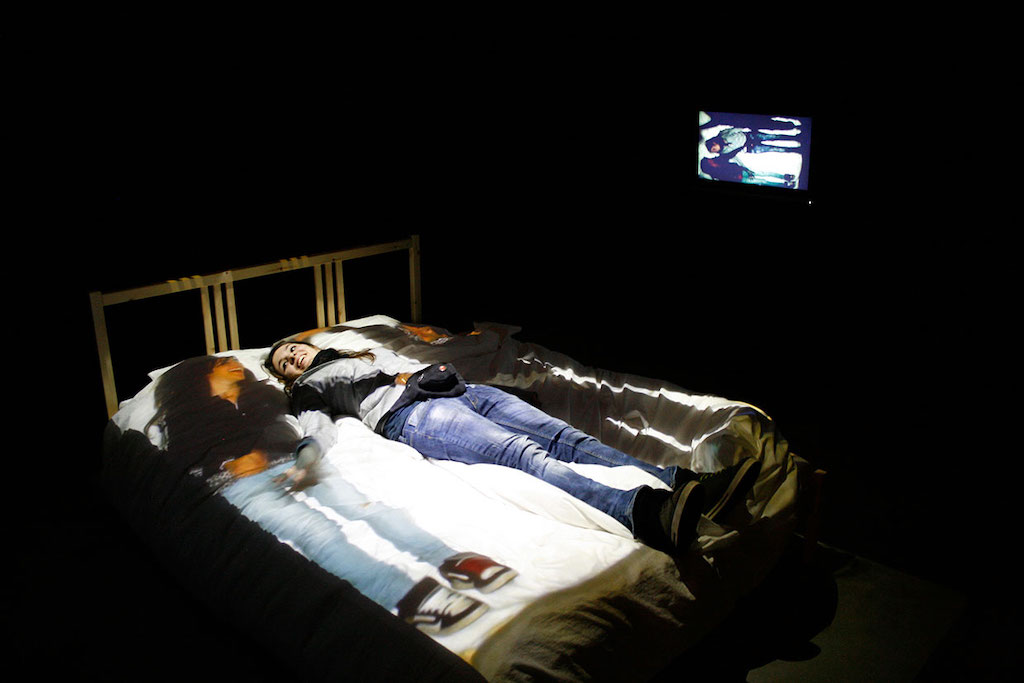Light Touches Skin
A game that uses projection to move peoples’ bodies.
produced by: Claire Kwong
Introduction
Inspired by partner dance, this installation aims to stage collaborative encounters between people. It seeks to destabilize the senses and push boundaries of intimacy.
Feel the projections against your skin. Stretch your body to deform them. Dance with someone until you fit a shape. Complex movements emerge through simple rules. Shared awkwardness can bring you closer together.
To play, move your bodies to touch all of the triangles.


Concept
Game Design
I wanted to create an out-of-body experience, expanding peoples’ ideas of how they can feel, move, and communicate. I also wanted to make people cooperate and dance with each other, even touch each other. I tried to create the potential for intimacy while maintaining mutual consent.
I adapted several principles from game design. Embodied play utilizes the normal affordances of the body, but can also extend or subvert them. I want to enable players to move in all the ways they usually do, but augment this with new movements and capabilities like controlling projections.
With emergent play, I let complex relations arise from simple rules. In this game, the rules come from the generated targets which choreograph players’ movements. I tried to strike a balance between constrained and spontaneous movement. The triangles are not prescriptively shaped to a human body, but allow room for individual interpretation. Gameplay is also circumscribed by the limits of players’ own bodies. Much of the fun of my game comes from pushing those boundaries and making it necessary to collaborate with others.
The game also creates asymmetric play. A person is limited by the perspective and affordances of their own body. For example, one player may see an untouched triangle behind another player. Players must communicate to figure out which triangles each of them should touch. In this way, asymmetric play creates the potential for collaboration.
I aimed to create a magic circle, Johan Huizinga’s concept where a game suspends normal social rules and replaces them with its own. I relate this to Nicolas Bourriaud’s notion of relational aesthetics, where art constructs situations which elaborate alternative forms of sociability. I tried to enable players to feel, move, and communicate in alternate, expanded ways.
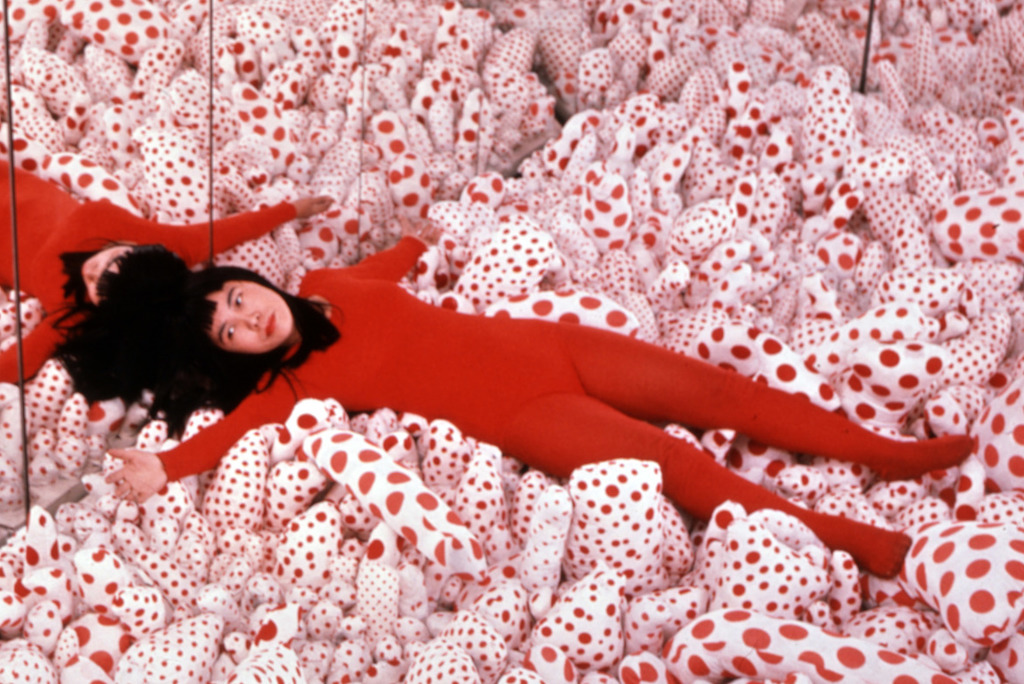
Visual
Visually, I drew from a variety of sources. I was inspired by pictures of outer space, which feature brightly colored imagery on a black background. I looked at illustrations with neons, gradients, and duotones to determine my color scheme. I also tried to create contrast between organic forms, like Yayoi Kusama’s polka dots, and geometric shapes, like Sol LeWitt’s wall drawings.
I also wanted to make people physically feel the projections on their skin, as if they had texture. I thought of visuals that could approximate or induce visceral sensations. I created animated dots of varying sizes and colors, because those could evoke goosebumps while being abstract enough to generate.
Influences
I was influenced by several categories of artwork: games, performances, and interactive installations. Originally, I was inspired by the classic physical game Twister. I love how its simple rules can create many ways of physical contortion and closeness. I also looked at Kaho Abe’s “Ninja Shadow Warrior” and Phoenix Perry’s “Bot Party” as technological games involving collaborative movement and touch.
I also looked at performances with bodies and projection. The artist Catherine Siller uses the Kinect, projection, and dance to stage riveting performances. Further back, I looked at interactive projection installations, like Pipilotti Rist’s immersive video work and Paul Sermon’s installation “Telematic Dreaming.” Finally, as above, I was inspired by relational art which constructs alternate social situations. For example, Marina Abramovic’s performances stage tense encounters between performer and audience.
I built on previous games I created for the Approaches to Play modules. This year I developed “Chromapose” and “Interpose”, web-based mobile games which use the accelerometer to sense your position and push you to move together with other players. For “Light Touches Skin”, I aimed to create an immersive space that allows more player movement.


Technical
Hardware
I designed and built a rig to project an image onto the floor. I built a wood frame to enclose the projector, then attached two metal brackets above the projector lens. I hung a laser cut mirror at an angle, and mounted the Kinect on top.
On the floor, I constructed an 11 by 8 foot mat with white interlocking foam tiles. This was intended to provide a white surface for projection, as well as a soft cushion for players to lay on. I hoped to evoke a children’s play area to inspire a playful mood.
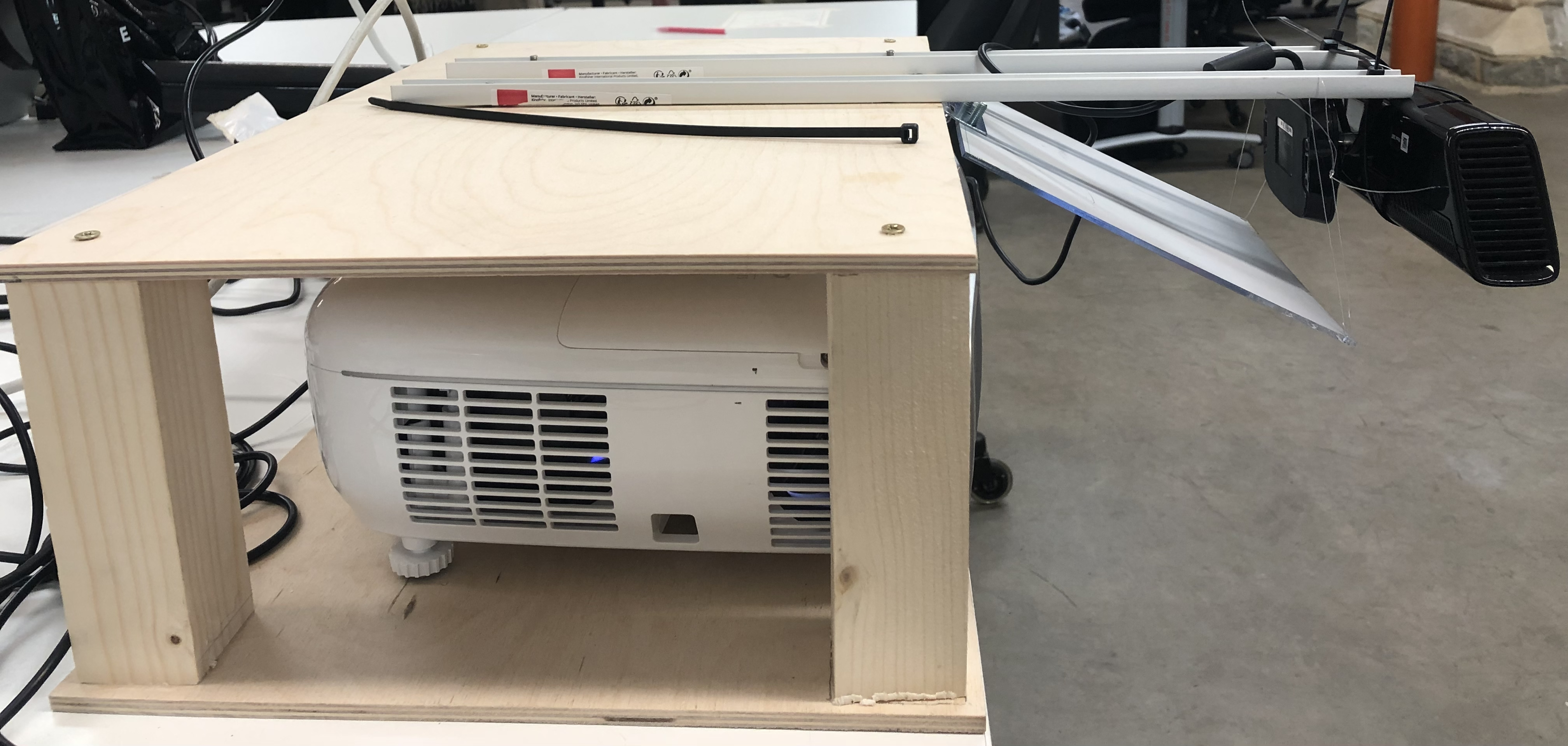

Software
I wrote the code in OpenFrameworks. I use the ofxKinect and ofxOpenCv libraries to get video from the Kinect depth camera. The code thresholds depth values to create silhouettes of peoples’ bodies, then translates them into OpenCV blobs. I smooth each blob into a shape, and then use them as masks for the polka dot texture.
I generate the target triangles with a custom algorithm. First, I listed pentominoes, shapes created from permutations of five blocks. For each target shape, I randomly pick a pentomino, which I scale to the approximate size of one person (5 by 5 feet). Then, I generate random points that fall within those pentominoes. Finally, I use the ofxDelaunay library to triangulate those points. This algorithm creates varied shapes that are possible to fill with a body.
Each frame, I iterate over all the triangles. If a triangle intersects with a blob, that indicates a person is touching it, and the triangle turns gray. When all triangles are touched, they morph into a new shape.
The software senses whether there is one or more people in the space using the number of blobs and the total number of pixels they contain. If one person is present, I generate shapes from one pentomino; if two or more are present, I use two, which creates a more complex shape that spans the whole play area. When two players touch, their blobs become one and the color changes. If they get very close, the game can revert to single player mode, which makes it more intimate.


Future development
If I install this game in the future, I’d position the projector to minimize shadows. I could mount the projector from the ceiling to point straight down, or even use two projectors from different angles.
I’d like to change the gameplay to encourage players to get on the floor more. The game is completely playable while standing up, because as a player rises higher off the floor, the Kinect sees them as closer and larger. I could explore alternate forms of computer vision, or even pressure sensors under the floor. I think this would further subvert normal modes of movement and encourage more expressive play.
Furthermore, I'd like to explore more complex forms of communication between players. I would try to create an emotional feedback loop between players with a greater need for interdependence – perhaps people can rely on each other, or even conflict with each other. I’d like players to control the shapes in more complicated ways, like pushing and pulling them. I could also introduce a competitive element through timers and scores.
Finally, I want to further explore the idea of intimacy. I'd try to encourage people to touch each other. I went through several iterations which did require players to touch – for example, players had to fit inside a shape. However, this proved awkward during play testing, and the exhibition format privileged more casual play.
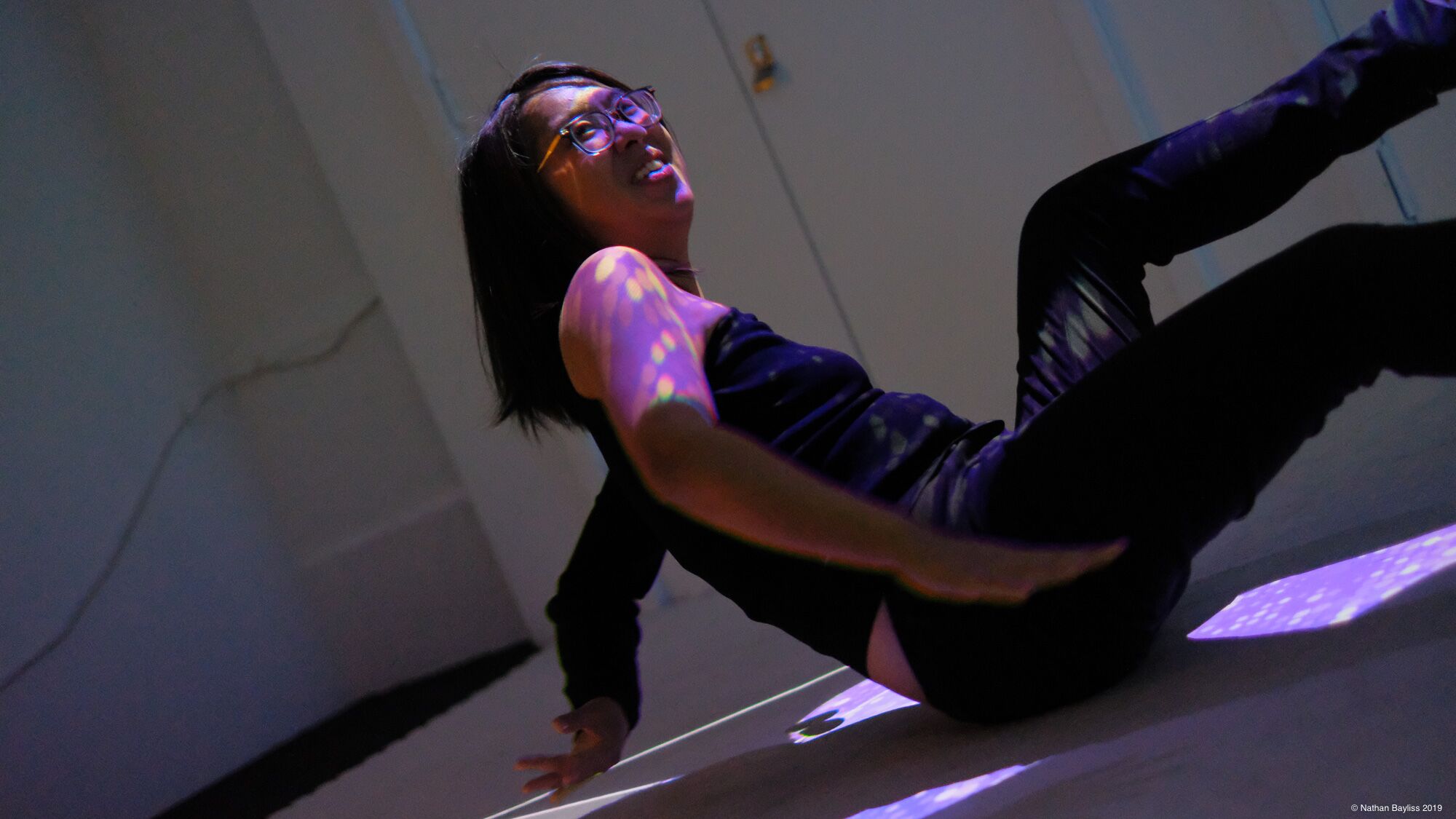

Self evaluation
I’m happy with how "Light Touches Skin” turned out. I watched people play the game in different, sometimes unexpected ways. I was pleased that people figured out how to play on their own. Many people seemed to have fun with it and gave me good feedback. However, I observed that people tended to look at the projections rather than their skin or each other.
I found that people engaged with it on the surface as a fun game, but may not have easily seen the underlying concepts of embodiment and intimacy. To make these concepts more visible, I could redesign the game to force more closeness and discomfort.
From the beginning of development, I aimed to make people touch each other. I ended up removing touch as a required game component. Touch was possible if players consented to it, and I observed some players touching, but it wasn’t a core element of gameplay.
Because the format was an installation which people pass through, it biased me toward casual forms of play with fewer barriers to entry. During development, I felt conflict between creating an intimate, conceptual game, which could stand as an idea even if people weren’t willing to play it, and a game which anyone could feel comfortable playing. For this exhibition, I chose the latter.
Touch is hard. Society establishes strong boundaries against touching other people, and one game may not be enough to overcome it. At one point, a player observed that everyone avoided touching each other, which could be a symptom of the UK’s touch-averse culture. Still, I think I succeeded in creating intimacy through shared movement and communication.
References
Abe, Kaho. “Ninja Shadow Warrior.” http://kahoabe.net/portfolio/ninja-shadow-warrior/
Abramovic, Marina. “Rhythm 0.” https://www.guggenheim.org/artwork/5177
Bishop, Claire, editor. Participation. Cambridge: The MIT Press, 2006.
Huizinga, Johan. Homo Ludens: A Study of the Play-Element in Culture. New York: Random House, 1938.
Kusama, Yayoi. “Biography.” http://yayoi-kusama.jp/e/biography/
LeWitt, Sol. “Wall Drawings.” https://www.diaart.org/program/exhibitions-projects/sol-lewitt-collection-display
Papatheodorou, Theo. “Flatlander.” In Workshops in Creative Coding 2, Week 11. https://learn.gold.ac.uk/course/view.php?id=11521§ion=11
Papatheodorou, Theo. “Kinect fiery comet.” In Workshops in Creative Coding 2, Week 16. https://learn.gold.ac.uk/mod/page/view.php?id=600308
Perry, Phoenix. “Bot Party.” http://playbotparty.com
Perry, Phoenix. “Feeling the Fear: Creating Emotion through Embodied Play Design.” 2013. https://www.academia.edu/1904999/Feeling_the_Fear_Creating_Emotion_through_Embodied_Play_Design
Rist, Pipilotti. “Another Body from the Lobe of the Lung Family.” https://www.mca.com.au/pipilotti-rist/tour/work/8
Sandor, Levente. “Nervous Waves 2.” https://www.openprocessing.org/sketch/153224
Schmidt, Deborah. “kinectExample.” https://github.com/openframeworks/openFrameworks/tree/master/examples/computer_vision/kinectExample
Sermon, Paul. “Telematic Dreaming.” http://www.medienkunstnetz.de/works/telematic-dreaming/
Siller, Catherine. “Voiced/Unvoiced.” http://catherinesiller.com/performances/voiced-unvoiced
































































